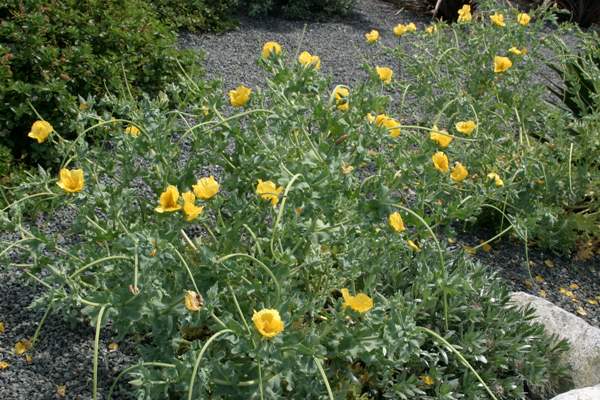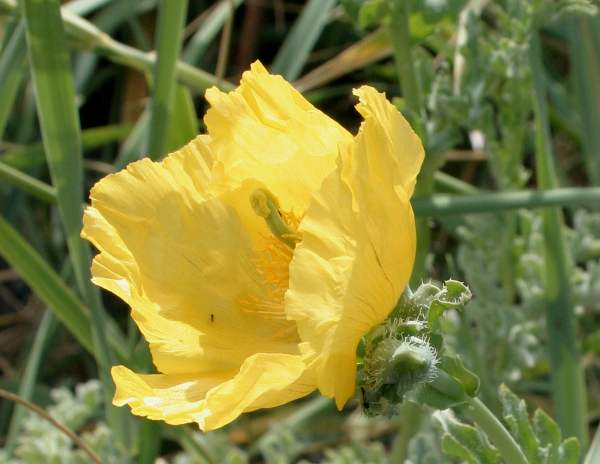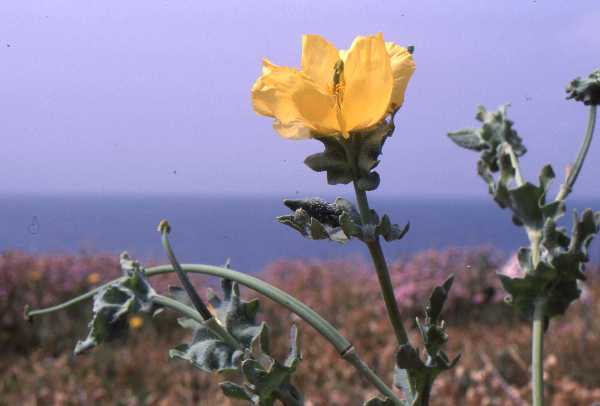Trees Birds Mammals Fish Amphibians Reptiles
Wild Algarve
Bookshop
Glaucium flavum - Yellow Horned-poppy
Phylum: Magnoliophyta - Class: Equisetopsida - Order: Papaverales - Family: Papaveraceae

Talk of poppies and most people see red, but there are some yellow poppies too and Yellow Horned-poppy is one of the most distinctive of the bunch.
Description
Apart from its stunning bright yellow flowers this plant is characterised by the elongated fruits, which can be up to 30cm in length - the so-called 'horns'. Yellow Horned-poppy is poisonous, and when the stems are cut or broken a yellow juice seeps out.

Distribution
Localised but fairly widespread along the coasts of Britain and Ireland, Yellow Horned-poppy is native to Britain, but it is also frequently cultivated and grown in gardens. This wildflower is found on the coasts of northern Europe and as far south as the Mediterranean region.
Occasionally plants of Glaucium flavum will pop up inland, but apart from garden escapes these plants are nearly always found in places that would have once been right beside the sea but where the land has subsequently been 'reclaimed' and then disturbed, causing the seeds to germinate and grow.

Habitat
Yellow Horned-poppy forms clumps on shingle and sandy beaches; it also grows in some sand dunes.
Blooming Times
The flowers of Glaucium flavum can be seen in the wild in Britain and Ireland from June through to September.
Uses
In the past oil produced from the seeds of Yellow Horned-poppy were used to make soap; it was also burned in lamps - no doubt in an age when these coastal wildflowers were far more plentiful than they are nowadays. Yellow Horned-poppy seed oil contains glaucine, an alkaloid that can be used in cough medicines.
Etymology
Glaucium, the generic name, comes from the Greek From the Latin glaucus or the Greek glaukos and is a reference to the glaucous (waxy-blue-green or greyish) colour of the leaves. The specific epithet flava means yellow.
The common name is sometimes written as Yellow Horned Poppy.
Similar Species
Welsh Poppy Mecanopsis cambrica has yllow flowers but it does not produce thevery long seed capsules that are characteristic of Glaucium flava.
The pictures of Yellow Horned-poppy shown on this page were taken at Cemaes Bay Nature Reserve on Anglesey, North Wales, during August.
Sue Parker's latest ebook is a revised and enlarged edition of Wild Orchids in The Burren. Full details here...
Buy it for just £5.95 on Amazon...
Sue Parker's new ebook is a comprehensive and fully revised edition of her acclaimed field guide to the Wild Orchids of Wales. Full details here...
Buy it for just £5.95 on Amazon...
Please Help Us: If you have found this information interesting and useful, please consider helping to keep First Nature online by making a small donation towards the web hosting and internet costs.
Any donations over and above the essential running costs will help support the conservation work of Plantlife, the Rivers Trust and charitable botanic gardens - as do author royalties and publisher proceeds from books by Pat and Sue.